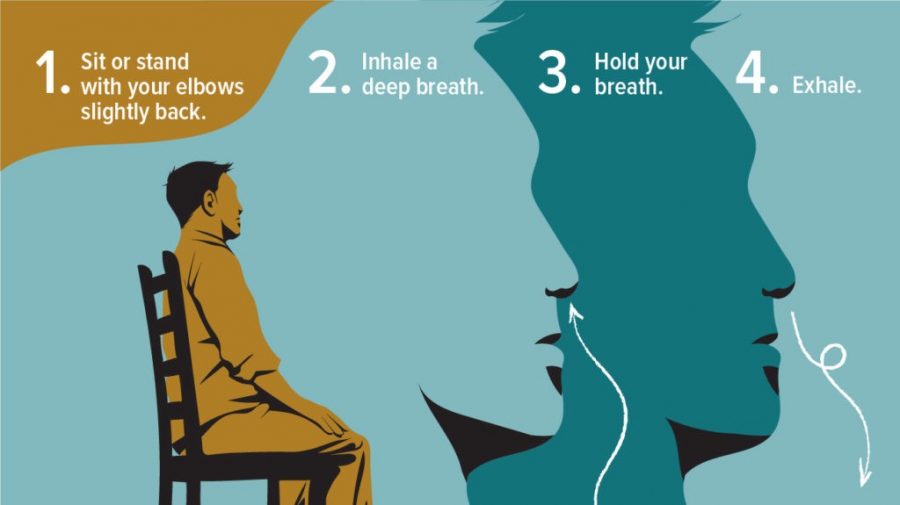Breathing Techniques and Calming Exercises
Deep breathing can help with feelings of anxiety and help to keep the mind grounded.
November 3, 2020
Everyone knows how to breathe but not correctly. Over 90 percent of people are using less than 50 percent of their breathing capacity, by taking a minimal amount of oxygen needed with small, shallow breaths. Breathing correctly can reduce high-stress levels, increase better blood flow to the rest of the body, and much more.
Many different cultures across the world include breathing techniques in their lifestyles. Chinese Qigong (chee-gong), Buteyko (Bu-tay-ko) and Ujjayi (ooh-JAI-yee) are just a few practices still used today by many people. Quick and simple techniques have proven to make a person healthier, relax more, and reduce tension.
Other types of breathing techniques include belly breathing, pursed lip breathing, mindful diaphragmatic breathing, breath focus,
Places you can incorporate breathing techniques in everyday routines and practices are yoga, meditation, and pranayama. Taking a few minutes each day to do deep breathing can help reduce anxiety and make for a clearer mind.
Most popular breathing techniques include straight and correct posture, and deep breaths by a counting system. The 4-7-8 technique involves breathing in through your nose for four counts, holding it for seven and then releasing for 8, counting as one breath.
Belly breathing is also a technique that involves lying down, putting one hand on your stomach and one on your chest and taking a deep breath through the nose so that your stomach pushes your hand out and your chest does not move. Then, breathe out through pursed lips and feel the hand on your stomach move in.
Morning breathing is a technique used to relieve muscle stiffness and clear clogged breathing passages. From a standing position, bend forward from the waist with your knees slightly bent, letting your arms dangle close to the floor. As you inhale slowly and deeply, return to a standing position by rolling up slowing, lifting your head last. Hold your breath for just a few seconds in this standing position. Exhale slowly as you return to the original position, bending forward from the waist.
To learn about more deep breathing techniques, click here.
Breathing control is most important in the event of anxiety and panic attacks. If you have never had a panic attack before but have symptoms of one, don’t be afraid to ask for help. Call someone you trust and ask them to talk you through it. Listen to your body’s needs and concentrate on your breathing, your intuition is important.
If you notice someone in distress or who looks like they may be struggling with their breathing due to a panic attack, ask if you can stay with them or if they want you to get someone for them first. If they show signs of heavy breathing, trembling, sweating, noticeable chest or stomach pain, chills, that person may be having a panic attack. Panic attacks are quite common, with 40 percent of the population experiencing panic attacks.
Make it known that you are there for them. A light touch or arm around their shoulder may calm them, but don’t do it if you don’t know that person that well. Next try to calm them down, by distracting them or helping with evening their breathing with the techniques described above. You can also ask them questions to focus on something else, like their favorite color, the time or to describe their surroundings with the five senses. Call 911 if you or anyone else cannot help calm the person down, if their attack worsens, or they want more help. Do not ask them why they are having a panic attack, and do not touch them without their permission first.
To find out more about how to help someone having a panic attack, click here.

